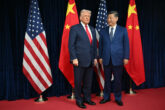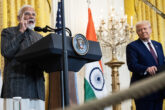April 30, 2024
Beyond China's Black Box
Five Trends Shaping Beijing’s Foreign and Security Policy Decision-Making Under Xi Jinping
Executive Summary
China’s foreign and security policymaking apparatus is often described as a metaphorical black box about which analysts know little. That is true to an extent, but at the same time, it is possible to develop a better understanding of the people, institutions, processes, and pressures that go into making China’s policies toward the world during Xi’s “new era,” that is, his time as the country’s top leader. This report pursues that objective by identifying five major trends mostly internal to the People’s Republic of China (PRC) party-state system that shape its foreign and security policymaking. In addition, the paper describes the effects that each trend generates, from bureaucratic incentives to behavioral patterns.
The first trend is personalization of the system around Xi. It reduces the influence of various interest groups and therefore the need to bargain with and among them, raises the prospect of groupthink among the loyalists Xi has surrounded himself with, and potentially increases the importance of achieving certain goals for China on Xi’s watch. In addition, Xi’s centrality creates a major management bottleneck that could hamper the system during even brief absences.
The second trend is empowering the Chinese Communist Party (CCP) over the state. That trend has made more officials into policy-implementers rather than policymakers, even on issues below the level of strategy. It has also increased central demands for ideological activities, such as Xi Jinping Thought study sessions. At the same time, while the leadership wants to improve coordination and might be making some progress, it stops short of actions that could allow government organs to coordinate horizontally if doing so might plausibly jeopardize the center’s control.
The third trend is domestic policy headwinds and the search for alternative forms of political legitimacy for the CCP. This creates two contradictory pressures: China’s reaching out and trying to improve ties with the world, and its turn to an assertive and at times even aggressive form of nationalism to counteract stalling economic growth. It also dents the power and influence China gained through its rapid rise and its role as a massive market driving global economic growth.
The fourth trend is further elevation of regime security over other concerns. This trend negatively affects Beijing’s ties with foreign countries by worsening the experience of foreigners visiting and living in China, exporting repressive political ideas and techniques to the world, and complicating how China’s foreign and security bureaucracy interacts with its counterparts.
The fifth and final trend is diplomatic and military assertiveness and seeking an active global leadership role, which feeds a self-reinforcing cycle of growing tensions, requires PRC diplomats to shoehorn any activities into Xi’s marquee frameworks, and leads Beijing to build out structures of an alternative international order.
Examining these trends helps illuminate the macro pressures shaping China’s foreign and security policy decision-making. Still, aspects of how the party-state makes decisions about its foreign and security policies—“known unknowns” —remain particularly opaque. These include information flows to senior leaders, the dynamic among Xi and his top advisors, and the structure and frequency of important meetings. More knowledge in those areas might shed light on larger questions related to whether there are informal constraints on Xi’s power and how Xi is thinking about eventual transfer of power.
To better understand and respond to the intricacies of China’s foreign and security policy decision-making, the United States and like-minded partners should:
- Recognize that Xi’s personal style and preferences are now the dominant factor shaping China’s foreign and security policies—but how that reality manifests will continue to evolve.
- Track how trends shaping China’s foreign and security policy decision-making might affect the country’s various bureaucratic institutions differently.
- Anticipate uncoordinated PRC actions, such as the 2023 spy balloon incident, as well as policies characterized by drift followed by rapid shifts because they reflect structural features of the system.
- Prepare for deepening policy contradictions alongside continued assertive nationalism from Beijing.
- Prioritize direct diplomatic interactions with Xi.
- Formally compare assessments of the PRC system with allies and partners.
- Develop contingency plans for different leadership succession scenarios.
Introduction
China’s growing power and assertiveness in East Asia, the Indo-Pacific, and around the world has increased the importance of understanding how Beijing’s foreign and security policymaking apparatus functions. Decisions made in China increasingly reverberate around the world, whether it is military pressure targeting Taiwan or Chinese fishing fleets trolling off the coast of South America. However, insights about which factors and actors truly shape Beijing’s foreign and security policies have become seemingly harder to find. Analysts can observe from the outside that an amalgam of Chinese Communist Party (CCP) organs and People’s Republic of China (PRC) state bodies—often short-handed as the “party-state”—shape decision-making processes. And CCP General Secretary Xi Jinping reigns from the top as the ultimate authority.
It is possible to develop a better understanding of the people, institutions, processes, and pressures that go into making China’s policies toward the world during Xi’s “new era,” that is, since he became leader in November 2012.
Analysts frequently characterize what happens within that system, though, as a metaphorical “black box” wherein we do not know how decisions are made. Even senior U.S. officials with access to classified information confess to a lack of knowledge about how Beijing makes foreign and security policies. As former U.S. Defense Secretary and Director of Central Intelligence Robert Gates told one reporter, “Our intelligence on [China’s] military capabilities and on their economy is pretty good. Our intelligence on what goes on behind closed doors, at the party leadership level, is . . . a very, very hard target.”1 Those descriptions are accurate to a degree. There are many things outside observers do not and cannot know relative to more transparent political systems such as those in liberal democracies.
At the same time, it is possible to develop a better understanding of the people, institutions, processes, and pressures that go into making China’s policies toward the world during Xi’s “new era,” that is, since he became leader in November 2012. This report pursues that objective by identifying five major trends mostly internal to the PRC party-state system that shape foreign and security policymaking. The description of those trends draws on an extensive analysis of public information about how China’s foreign and security policy apparatus makes and executes decisions. In addition, the discussion of each trend describes the effects, from bureaucratic incentives to behavioral patterns, it generates.
These trends are not necessarily logically coherent either in principle or in practice. In fact, they are often contradictory. They are also interrelated and mutually reinforcing, rather than distinct. They do not, however, attempt to describe China’s view of the entire global landscape. Lastly, this framework is necessarily incomplete—the opacity of China’s party-state system still obscures most of its inner machinations—even as the report’s analysis attempts to shed some light on what goes on behind closed doors.
This report proceeds by elucidating the five trends and how their effects shape China’s foreign and security policy decision-making. They are (1) personalization of the system around Xi, (2) empowering the party over the state, (3) domestic policy headwinds and the search for alternative forms of political legitimacy, (4) elevation of regime security over other concerns, and (5) diplomatic and military assertiveness and seeking an active global leadership role. Next, the report details the “known unknowns” of China’s foreign and security policymaking apparatus in the hope of adding rigor to the discussion of what specifically analysts want to find by opening the black box.2 Finally, the report offers policy recommendations for the United States and like-minded allies and partners seeking a better understanding of the PRC system both to interpret and shape Beijing’s behavior.
- Robert Gates as quoted in Bob Davis, “Robert Gates on the Military’s Relationship with China,” The Wire China, November 19, 2023, https://www.thewirechina.com/2023/11/19/robert-gates-on-the-militarys-relationship-with-china. ↩
- Donald Rumsfeld, “Known and Unknown: Author’s Note,” The Rumsfeld Papers, December 2010, https://papers.rumsfeld.com/about/page/authors-note. ↩
More from CNAS
-
Indo-Pacific Security / Energy, Economics & Security
How to Win the Economic War with ChinaTrump's approach to China has run aground, giving Beijing unprecedented advantage in the economic conflict....
By Edward Fishman & Julian Gewirtz
-
America’s Self-Loathing Is a Losing Hand
This article was originally published in The Washington Post.Around 10 years ago, the United States began a historic shift in its grand strategy toward China, abandoning the b...
By David Feith
-
Indo-Pacific Security / Energy, Economics & Security / Technology & National Security
Selling AI Chips Won’t Keep China Hooked on U.S. TechnologyU.S. policy should not rest on the illusion that selling chips can trap China inside the American tech ecosystem....
By Janet Egan
-
Will New Delhi-Beijing Move Beyond Friction Points? | Ex-White Official On India-China Reset
Prime Minister Narendra Modi on Friday said that India and China, as two major economies, must work together to bring stability to the global economic order. NDTV's Gaurie Dwi...
By Lisa Curtis





